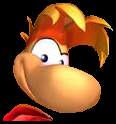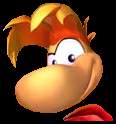Rythm
platform and management - Part III
What
changes did you make to the fights when the bosses are on the scene?
Benjamin
Haddad
If we go back to the example of Razoff, we played a cat-and-mouse
game. Generally speaking, you rarely see enemies leave or run away from a fight.
This is even truer for a boss who is normally fought in an arena, a clearly delimited
place that no-one can escape from. Here, we had fun doing completely the opposite.
The level's a chase between Razoff and Rayman, going through the whole house.
Razoff hides in strategic places to snipe at Rayman, or he pops out at a bend
in a corridor to take him by surprise. Rayman can shoot at him, then starts haring
after him through the corridors.
How did you manage
all these different elements while keeping the game varied and rhythmic?
Michael
Janod
As a matter of fact, the main aim was to keep a sustained rhythm,
while using surprises sparingly and following a curve of increasing difficulty.
On that basis, you can create heaps of more or less effective theories. For our
part, we were very pragmatic. We laid down a few very simple principles: from
the moment he moves forward, the player can't remain 15 seconds without acting
- so there are no long, empty corridors - and he should be obliged to combine
all of Rayman's movements and powers. From there, we tested and figured out what
was missing or what didn't work. After a test, we realize that the gameplay is
too repetitive, or not intense enough, and we change it accordingly. Then we test
again, and continue the procedure, until the level of intensity's just right.
Benjamin
Haddad
For the surprises, we relied a good deal on the scenario. Since
the story and the sense of immersion in the game made it possible to set up genuine
surprise developments, we fooled around a little by taking the player from the
rear. The bosses, for example, are normally always at the end of each part of
a game. You go through a whole universe and, at the end, you have the final boss
who allows you to move on to the next universe. Here, we had fun putting bosses
where the player least expected them - smack in the middle of a universe, or even
at the entrance!
Why did you create a scoring
system in the game?
The score's there to encourage good players
to play even better. A player who finds the going tough is happy just to get to
the end of the game. A good player's sure to get to the end, but - in addition
- he'll have kept tab of his score, which is a very important element of comparison.
In RM2, players could try to reach a final goal, which was to finish the game
100%, picking up all the yellow Lums. Here, we've created a kind of open competition
in which anyone can beat the previous record, a bit like the Olympic Games. These
scores are rewarding for the players, because they increase your prestige and
unlock secret game elements. Since the goal's fixed, the score's managed in such
a way as to make the player think. That's the tactical side of the game. The order
in which you do things, and the virtuosity with which you do them, can change
the score radically - and, in general, the more the player performs prestigious,
colorful tasks, the more points he wins. If he flunks part of the game, he can
do it again to try and improve his score, but he doesn't have to re-play the whole
game.
In the end, there seem to be an enormous
number of different things in the game. Weren't you afraid that the player might
get a little lost?
On the contrary! In fact, using the same
game system, we provide a wide variety of different forms, so the player never
replays exactly the same thing. For the player, that's the best present we could
give!
Source: Ubisoft/Raymanzone
<<<
back to Interviews |





